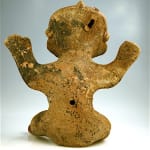Nayarit Seated Female Figure, 300 BCE - 300 CE
Terra Cotta
6
DJ.1023 (LSO)
Further images
This charming piece representing a seated man with splayed legs and upraised arms comes from the Mexican state of Nayarit, located on the Pacific coast. It is a very well-made...
This charming piece representing a seated man with splayed legs and upraised arms comes from the Mexican state of Nayarit, located on the Pacific coast. It is a very well-made and sensitive piece, expressionistically figurative with an oversized hear, rather childlike proportions and a somewhat reductivist set of facial features, in partially polychrome terracotta. The figure is naked, with what appears to be a sort of harness, or belt system around the thorax and with a strap that goes around the neck. The hands are raised in what is perhaps intended to represent surrender or as a gesture of positive intentions. The hair is darkly pigmented, with an appliqué central crest running down the centre. Condition is good and unrestored.
Archaeologically and historically Nayarit shares a great deal with Jalisco and Colima, not least its production of extremely high-quality ceramic vessels and figures. Comparatively little is known of the people who produced them; like their neighbours mentioned above, they lived in small agricultural communities, with strong reliance upon familial/ tribal networks, judging from the multiple family burials (shaft tombs) that have been discovered. These tombs, which are up to twenty metres deep, have supplied almost all the ceramics and social information we currently have about these populations. Known trends in sculptural theme include representations of ball-players, ancestor pairs, warriors, women (maternity figures) and zoomorphic pieces, although these are much more common in states such as Colima. Styles vary through time, although precise relationships are uncertain. The most realistic is the Ixtlan del Rio style of highly-adorned and accurately- modelled human figures with stylised faces. Nayarit tableaux are also known, constituting groups of abstract and figurative designs apparently intended to be devotional pieces. The best-known style is the Chinesco or Chinesca style, named for their supposedly Chinese appearance – impassive faces, linear eyes – of which there are five claimed types (the validity of the divisions is open to question due to their considerable overlap). Type A is unusual in its realism, while types B-E are more or less abstract, with major interpretation of proportions, limbs and faces.
This piece is a classical example of the latter style, and shares various characteristics with type “C”, although, as stated above, this is open to interpretation. The role of the piece is uncertain; those figures with exaggerated feminine characteristics may be connected in some way with fertility, but arguably one might argue that virility is better embodied by other means than this rather androgynous representation. Whatever its significance, however, the sophistication of Nayarit sculptors and their ability to move away from standard figurative concepts is well represented, and it also constitutes a striking and attractive piece of sculpture that would take a proud position in any collection of ancient Central American art.
Archaeologically and historically Nayarit shares a great deal with Jalisco and Colima, not least its production of extremely high-quality ceramic vessels and figures. Comparatively little is known of the people who produced them; like their neighbours mentioned above, they lived in small agricultural communities, with strong reliance upon familial/ tribal networks, judging from the multiple family burials (shaft tombs) that have been discovered. These tombs, which are up to twenty metres deep, have supplied almost all the ceramics and social information we currently have about these populations. Known trends in sculptural theme include representations of ball-players, ancestor pairs, warriors, women (maternity figures) and zoomorphic pieces, although these are much more common in states such as Colima. Styles vary through time, although precise relationships are uncertain. The most realistic is the Ixtlan del Rio style of highly-adorned and accurately- modelled human figures with stylised faces. Nayarit tableaux are also known, constituting groups of abstract and figurative designs apparently intended to be devotional pieces. The best-known style is the Chinesco or Chinesca style, named for their supposedly Chinese appearance – impassive faces, linear eyes – of which there are five claimed types (the validity of the divisions is open to question due to their considerable overlap). Type A is unusual in its realism, while types B-E are more or less abstract, with major interpretation of proportions, limbs and faces.
This piece is a classical example of the latter style, and shares various characteristics with type “C”, although, as stated above, this is open to interpretation. The role of the piece is uncertain; those figures with exaggerated feminine characteristics may be connected in some way with fertility, but arguably one might argue that virility is better embodied by other means than this rather androgynous representation. Whatever its significance, however, the sophistication of Nayarit sculptors and their ability to move away from standard figurative concepts is well represented, and it also constitutes a striking and attractive piece of sculpture that would take a proud position in any collection of ancient Central American art.





